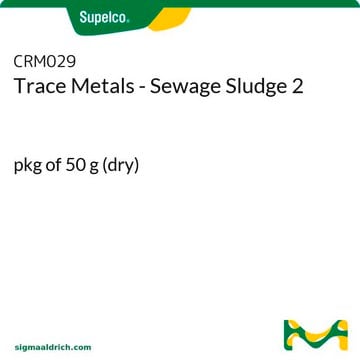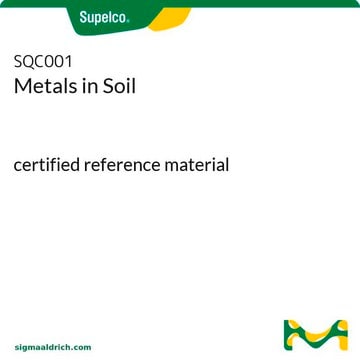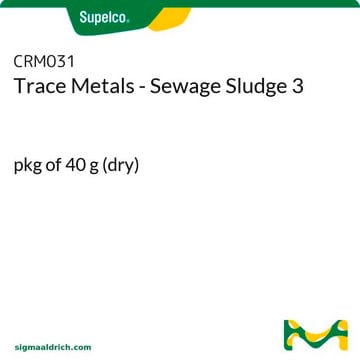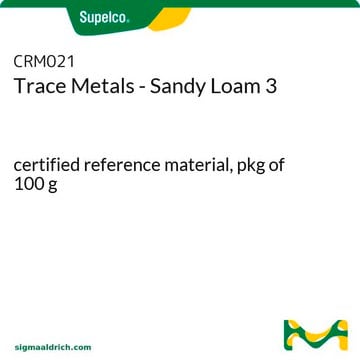CRM036
Trace Metals - Loamy Sand 4
certified reference material, pkg of 50 g
Synonym(s):
Sand matrix CRM, trace metals
Sign Into View Organizational & Contract Pricing
All Photos(1)
About This Item
UNSPSC Code:
41116107
NACRES:
NA.24
Recommended Products
grade
certified reference material
CofA
current certificate can be downloaded
packaging
pkg of 50 g
manufacturer/tradename
RTC CRM036-050
technique(s)
AAS: suitable
ICP: suitable
pH
4.34
application(s)
environmental
format
matrix material
storage temp.
2-30°C
General description
This Certified Reference Material (CRM) is produced and certified in accordance with ISO 17034 and ISO/IEC 17025. All information regarding the use of this CRM can be found on the certificate of analysis.
This product was produced and certified from a naturally contaminated matrix and has not been fortified or modified in any way. Analytical data for Certification was obtained using USEPA SW846, 3rd edition methods 3050 (hot block) and 3051(microwave) using nitric acid extraction. Analysis was carried out according to USEPA methods 6010 (ICP-ES), 6020 (ICP-MS) and 7000 (AES).
Application
- Trace Metal Analysis in Loamy Sand for Soil Health: Utilization of Trace Metals - Loamy Sand 4 for evaluating soil health and ensuring safe levels of metal contaminants. The analytical standard is crucial for environmental monitoring and ensuring compliance with regulations, particularly in agricultural land management and ecological studies (Sivapatham et al., 2014).
- Pharmaceutical Soil Testing for Environmental Safety: Trace Metals - Loamy Sand 4 serves as a key reagent for pharmaceutical companies to conduct soil testing and assess environmental impact. This high-quality extraction solution is instrumental for studies on the bioavailability of pharmaceutical compounds and their metabolites in the ecosystem (Shah et al., 2009).
- Biotech Trace Metals Standard in Agriculture: The use of Trace Metals - Loamy Sand 4 is vital in agriculture to ensure the safe application of biosolids and manage trace metal accumulation. Its role in biotech research is to safeguard crop health and study the transfer of metals to the food chain (Sukkariyah et al., 2007).
- Soil Remediation Studies: Trace Metals - Loamy Sand 4 is essential in soil remediation research, helping to optimize conditions for extracting heavy metals from contaminated soils. It aids in developing environmentally sustainable practices for cleaning up polluted sites (Andrade et al., 2007).
- Monitoring Soil Lead Transformation: In studies on the transformation of lead in soils, Trace Metals - Loamy Sand 4 is critical for understanding how lead oxide particles change over time. This research has implications for public health and environmental protection strategies (Birkefeld et al., 2007).
Other Notes
Values of analytes vary lot to lot. Some lots may not contain all analytes.
Analyte
Description
Aluminum
Antimony
Arsenic
Barium
Beryllium
Boron
Cadmium
Calcium
Chromium
Cobalt
Copper
Iron
Lead
Magnesium
Manganese
Mercury
Molybdenum
Nickel
Potassium
Selenium
Silver
Sodium
Thallium
Tin
Vanadium
Zinc
See All (26)
Signal Word
Danger
Hazard Statements
Precautionary Statements
Hazard Classifications
Aquatic Chronic 2 - Carc. 1B - Eye Irrit. 2 - Met. Corr. 1 - Skin Irrit. 2 - Skin Sens. 1
WGK
WGK 3
Choose from one of the most recent versions:
Already Own This Product?
Find documentation for the products that you have recently purchased in the Document Library.
Ting Yang et al.
The Science of the total environment, 647, 290-300 (2018-08-07)
Humic acid can effectively bind several metals and is regarded as a promising soil washing agent. Previous studies indicate that carboxylic groups dominate metal binding to humic acid. In this study, a synthetic humic-like acid (SHLA) with high COOH content
Our team of scientists has experience in all areas of research including Life Science, Material Science, Chemical Synthesis, Chromatography, Analytical and many others.
Contact Technical Service











